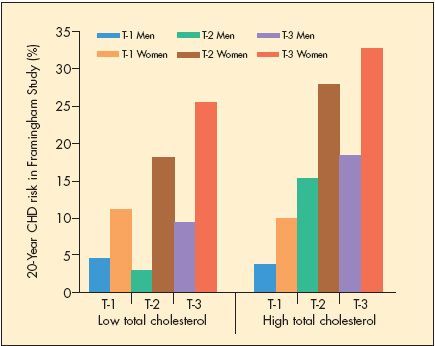- Clinical Technology
- Adult Immunization
- Hepatology
- Pediatric Immunization
- Screening
- Psychiatry
- Allergy
- Women's Health
- Cardiology
- Pediatrics
- Dermatology
- Endocrinology
- Pain Management
- Gastroenterology
- Infectious Disease
- Obesity Medicine
- Rheumatology
- Nephrology
- Neurology
- Pulmonology
Treatment Dilemma: Favorable Lipid Ratio With an Elevated LDL
Is it necessary to prescribe lipid-lowering therapy for a patient with a mildly elevated total cholesterol level (240 mg/dL), a low-density lipoprotein (LDL) cholesterol level of 120 mg/dL, and a high high-density lipoprotein (HDL) cholesterol level of 100 mg/dL?
Is it necessary to prescribe lipid-lowering therapy for a patient with a mildly elevated total cholesterol level (240 mg/dL), a low-density lipoprotein (LDL) cholesterol level of 120 mg/dL, and a high high-density lipoprotein (HDL) cholesterol level of 100 mg/dL?
- Mary Ellen Lewis, PA-C
A favorable lipid ratio in association with a high LDL cholesterol level is a troublesome-and fairly common-therapeutic dilemma. Because an HDL cholesterol level of 100 mg/dL is unusually high, it would be prudent to confirm the accuracy of the lipid values.
Also, HDL cholesterol can be dysfunctional, negating its protective role in transporting cholesterol out of the arterial intima. This is caused by an HDL-C mutation of the cholesteryl ester transfer protein gene. However, this is not common in the population. Thus, it might be prudent to treat the elevated LDL cholesterol, particularly if there is a family history of premature coronary disease or a high global risk of the disease.

Regarding the lipid ratio, it is apparent from Framingham Study data that coronary heart disease (CHD) risk is strongly linked to the total/HDL cholesterol ratio-whether or not either the total or the LDL cholesterol level is high.1 A total/HDL cholesterol ratio of 2.5 is, taken alone, highly favorable.
On the other hand, blood lipids, although fundamental to atherogenesis, are best viewed as one factor in a cardiovascular risk profile. Their impact is profoundly influenced by the associated blood pressure. Atherosclerosis does not develop in the low-pressure venous circulation, despite exposure to lipid-laden blood. Only when used as a conduit for cardiac revascularization do veins become vulnerable. Each 20/10 mm Hg increment in blood pressure doubles the cardiovascular mortality rate. Diabetes also doubles the risk associated with any given lipid value.
The Adult Treatment Panel III guidelines have wisely linked the indication for and aggressiveness of dyslipidemia therapy to the global CHD risk, which takes into account the blood pressure, diabetic status, smoking status, age, and sex of the patient.2 Considering the lipid levels in isolation from this other information is shortsighted. If the multivariable risk is very high (eg, 20% for 10 years) or the patient has already sustained an atherosclerotic cardiovascular event, aggressive therapy is indicated, despite the favorable ratio. This could include treatment with statins to reduce the LDL cholesterol level to 100 mg/dL.
The justification for such therapy lies in the pleotropic benefits of statins, such as their favorable effects on platelet aggregation and endothelial function. The Heart Protection Study showed benefit from statin therapy in high-risk patients with any LDL cholesterol level-even a low level.3
If your patient's multivariable risk is less than 10%, then only hygienic measures, such as a heart-healthy diet and periodic lipid monitoring, would be indicated given the highly favorable lipid ratio.
- William B. Kannel, MD, MPH
Professor of Medicine and Public Health
Boston University School of Medicine
Boston
References:
REFERENCES:
1.
Nam BH, Kannel WB, D'Agostino. Search for an optimal atherogenic lipid risk profile.
Am J Cardiol
. 2006; 97:372-375.
2.
Executive Summary of the Third Report of the National Cholesterol Education Program (NCEP) Expert Panel on Detection, Evaluation and Treatment of High Blood Cholesterol in Adults (Adult Treatment Panel III).
JAMA
. 2001;285:2486-2497.
3.
Heart Protection Study collaborative group. MRC/BHF Heart Protection Study of cholesterol lowering with simvastatin in 20,536 high-risk individuals: a randomized placebo-controlled trial.
Lancet
. 2002;360:7-22.
4.
Kannel WB. Lipids, diabetes, and coronary heart disease: insights from the Framingham Study.
Am Heart J.
1985;110:1100-1107.
